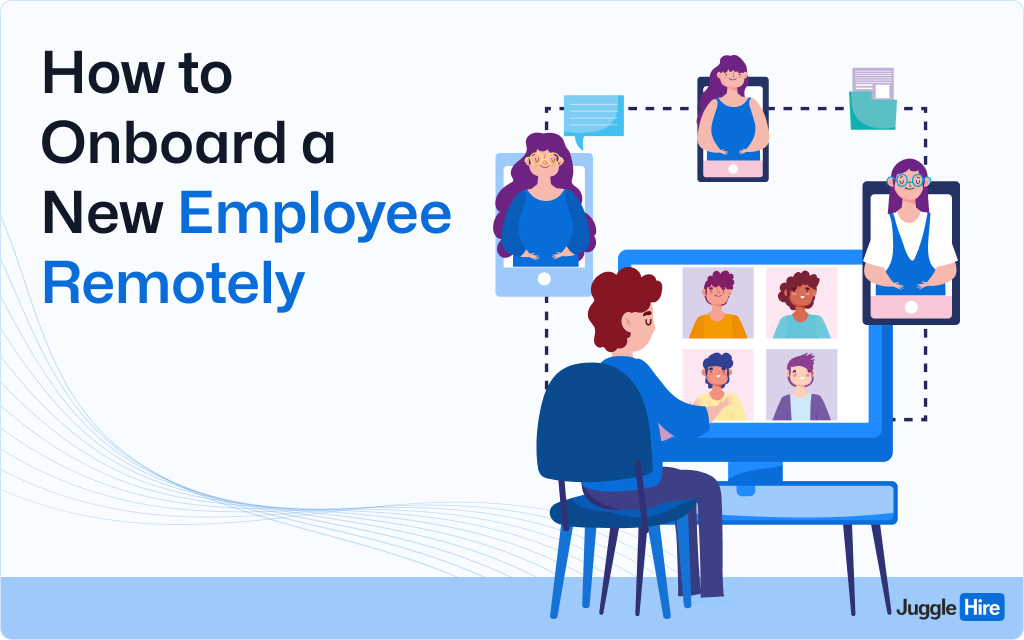As more companies embrace a digital-first approach, the task of remotely onboarding new employees has become a common challenge. Remote onboarding lacks the personal touch of face-to-face interactions, making it harder for new hires to feel connected and engaged with their new team and company culture.
Studies say, great onboarding can improve employee retention by 82%.Studies say, great onboarding can improve employee retention by 82%.
So, you can understand how important it is. However, without the right approach, new employees can feel isolated and unclear about their roles, which can impact their performance and overall job satisfaction. To address these challenges, we’ve created a comprehensive guide.
This article outlines 9 crucial steps on how to onboard a new employee remotely, ensuring they feel welcomed, prepared, and valued from day one. Let’s explore these steps to transform your remote onboarding process into a seamless and supportive experience.
What Is Remote Onboarding?
Remote onboarding is the process of integrating a new employee into a company without a physical presence in an office. This process includes sending necessary documents like contracts online for signing.
Training is given through video calls or online courses that the employee can do from home. The company ensures the employee has all the required software and tools.
Communication is kept up through emails, messaging apps, and video calls. This helps the new employee feel connected. Also, the company organizes virtual social events to help them blend into the company culture. This method helps new employees feel part of the team, even remotely.
9 Steps on How to Onboard a New Employee Remotely
As we dive into the 9 steps on how to onboard a new employee remotely, it’s important to follow a structured approach. Each step is designed to ensure that the new employee has everything they need to succeed and feels part of the team from the start. Let’s begin with the very first and crucial step:
1. Prepare Necessary Equipment and Access
When onboarding a new employee remotely, the first essential step is to prepare all the necessary equipment and access they will need to perform their job effectively from day one.
This preparation involves ensuring that the employee has the right hardware, such as a laptop, headphones, and any specialized tools specific to their role. Additionally, they should have all required software installed and ready to use.
It’s crucial to also set up access to all necessary platforms and systems. This includes email accounts, communication tools like Slack or Microsoft Teams, project management software, and any internal databases they will need to use. Make sure that all logins and passwords are organized and securely shared with the new hire.
Providing a seamless technical setup not only helps in reducing the initial stress and confusion but also empowers the employee to start contributing more quickly.
For instance, a graphic designer would need immediate access to design software like Adobe Creative Suite, along with any company-specific tools that are part of your creative process.
2. Send a Welcome Package
Sending a welcome package can greatly enhance the remote onboarding experience. This package should ideally include branded items such as notepads, pens, a company T-shirt, and anything else that can make the employee feel connected to the company culture. Additionally, consider including practical items like ergonomic desk accessories or a coffee mug.
This package can also contain a personalized welcome letter from the CEO or the direct manager, expressing excitement about the new hire’s arrival. Such gestures help in building a sense of belonging and enthusiasm about joining the team.
A new remote employee at a tech company might receive a welcome kit that includes company-branded merchandise, a tech gadget like a USB hub, and a personalized card. This approach not only makes the new employee feel valued but also conveys the company’s culture and values right from the start.
3. Share Important Documents and Policies
The next step is to ensure the new employee has all the necessary documentation and understands the company policies. This includes the employee handbook, health and safety guidelines, privacy policies, and any other relevant materials that govern how your company operates. These documents should be shared digitally and organized in a way that is easy to navigate.
It’s also beneficial to schedule a meeting or a video call where these documents can be reviewed together, allowing for any questions and clarifications. This helps ensure that the employee fully understands the expectations and the operational framework of the company.
For instance, you might use a digital tool like Google Drive or a company intranet to share documents, where the employee can easily access and refer back to them as needed. It’s also helpful to highlight key policies that are crucial for immediate compliance, such as data security protocols or communication guidelines.
Also Read: Remote Hiring Tips: How To Attract, Hire and Retain Remote Employees
4. Host a Virtual Welcome Meeting
Hosting a virtual welcome meeting is a critical step in the remote onboarding process. This meeting serves as the official introduction of the new employee to the team and provides an opportunity for face-to-face interaction, albeit digitally. It’s important to schedule this meeting within the first week of employment to quickly integrate the new hire into the team.
During the virtual welcome meeting, each team member should introduce themselves and describe their roles within the company. This helps the new employee understand who does what and how they will fit into the organization. The manager should also give an overview of current projects and upcoming goals.
To make the meeting more engaging, consider incorporating interactive elements such as a virtual tour of the office, if applicable, or sharing fun facts about team members. For example, a team might use a platform like Zoom or Microsoft Teams to conduct the meeting, utilizing breakout rooms for smaller group interactions or ice-breaker activities.
5. Assign a Buddy or Mentor
Assigning a buddy or mentor to a new employee is an effective way to provide support and guidance during the initial stages of their remote work journey. The buddy or mentor should be a more experienced employee who can answer questions, help navigate the company culture, and introduce the new hire to other team members and important contacts within the organization.
This relationship is particularly crucial in a remote setting where the new employee might not have the opportunity to organically meet colleagues through office interactions. The buddy or mentor can set up regular check-ins via video call or chat to ensure the new employee feels connected and supported.
For instance, a new developer in a software company could be paired with a senior developer who provides insights into codebase management, project deadlines, and company best practices in coding. This not only accelerates the learning curve but also helps build a professional network within the company.
6. Set Clear Expectations
Setting clear expectations is vital in ensuring that the new employee understands their responsibilities and what is expected of them in their new role. This clarity helps prevent misunderstandings and sets the employee up for success. It is advisable to discuss job duties, performance goals, work hours, communication preferences, and feedback mechanisms early in the onboarding process.
Additionally, provide written goals and objectives that the employee can refer to and track their progress against. This documentation should be detailed and include specific metrics or milestones they are expected to achieve within set timeframes.
An example of setting clear expectations might be a project manager outlining the specific projects the new hire will take on, detailing the scope, deadlines, and key deliverables for each project.
Regular meetings should also be scheduled to review these goals, discuss any obstacles the new employee might be facing, and adjust expectations if necessary.
7. Schedule Training Sessions
Training sessions are essential for new employees to learn the skills necessary for their roles, especially when onboarding remotely. These sessions should cover both general company operations and specific job-related tasks. It’s important to organize these training sessions early in the onboarding process to give the new hire a solid foundation.
Use a mix of live video sessions and pre-recorded materials that new employees can review at their own pace. Ensure that the content is clear and accessible, and check in periodically to answer any questions that may arise.
For example, a customer service rep might need training on your company’s ticketing system, communication protocols, and product knowledge.
Additionally, consider using interactive tools like quizzes or practical tasks to make the training engaging. A good practice is to have trainers who are knowledgeable and approachable, creating a supportive learning environment that encourages the new hire to ask questions and fully engage with the material.
8. Encourage Social Interaction
Encouraging social interaction is crucial in a remote environment to help new hires feel part of the team. This can be achieved by setting up virtual coffee breaks, team lunches, or happy hours where team members can interact in a more relaxed setting. These social events should be regular to ensure ongoing engagement.
You can also use digital tools like Slack or Microsoft Teams to create social channels where employees can share non-work-related posts, such as pet photos, hobbies, or book recommendations. For instance, organizing a virtual trivia night or a remote “pet showcase” day can make new employees feel welcomed and build bonds with the team.
9. Ongoing Support
Ongoing support is critical for the long-term success of remote employees. This involves regular check-ins, encouraging participation in company events, and providing opportunities for growth.
- Regular Check-ins:
Schedule weekly or bi-weekly one-on-one meetings with the new hire to discuss their progress, address any concerns, and provide feedback. This helps the employee feel supported and valued.
- Encourage Participation in Company Events:
Involve remote employees in company-wide events, such as online workshops, guest speaker sessions, and annual meetings. This inclusion helps build a sense of belonging and keeps them informed about company developments.
- Provide Opportunities for Growth
Offer continuous learning opportunities such as online courses, webinars, and access to learning platforms. Encourage them to take on new projects that challenge their skills and allow them to grow within the company.
For example, a new marketing analyst might be encouraged to lead a small campaign or participate in a cross-department project to improve their skills and visibility in the company.
How to Onboard a New Employee Remotely: Wrapping Up
Remote onboarding is an effective way to welcome new employees into a company when they can’t be physically present. By utilizing digital tools for documentation, training, and communication, businesses can ensure that new hires are well-prepared and integrated into the team.
Virtual social interactions further enhance their experience, helping them feel connected and part of the company culture right from the start. With these strategies in our guide of how to onboard a new employee remotely, remote onboarding can be just as successful as traditional methods, setting both the employee and the company up for success.


